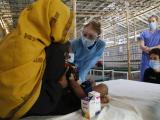Aug 9, 2011 (CIDRAP News) – A person hospitalized in Minnesota has contracted inhalational anthrax after traveling in western states, officials from the Minnesota Department of Health (MDH) announced today.
In a release, the MDH said that the agency and its partners at the US Centers for Disease Control and Prevention (CDC) are investigating the infection, which apparently stemmed from environmental exposure.
The individual is hospitalized in Minnesota after traveling to North Dakota, Montana, Wyoming, and South Dakota. Lab officials in Minnesota confirmed the illness. The MDH did not disclose the patient's name, age, gender, or medical condition, but said he or she is not a Minnesota resident.
Ruth Lynfield, MD, Minnesota state epidemiologist, said evidence suggests the patient was exposed from a natural source. The person had been exposed to soil and animal remains. She added that anthrax disease in hoofed animals occurs annually in certain parts of the country, including the Midwest and West. Animal infections can occur as far south as Texas and as far north as the Canadian border.
Because anthrax is considered a bioterrorism agent, the Federal Bureau of Investigation (FBI) conducted an initial investigation with the MDH, but it found no links to criminal or terrorist activity, the MDH said. The FBI is no longer actively investigating the case.
The rare infection in a human doesn't pose a risk to the public, Lynfield said. "Anthrax is not spread from person to person, and it is extremely rare for humans to become sickened with anthrax, especially through inhalation," she said in the statement. Human infections occasionally occur from handling contaminated animal hides or meat or from ingesting soil or meat tainted with the anthrax spores.
Officials said they aren't issuing any travel advisories, because infections are rare and Bacillus anthracis, the anthrax bacterium, is naturally found in the environment.
One of the last human anthrax infections in the United States occurred in late 2009 when a New Hampshire woman got sick with the gastrointestinal form of the disease after she participated in an event that involved the use of animal-hide drums.
An anthrax bioterror attack on the East Coast in the fall of 2001, involving spores sent through the mail, led to 22 illnesses and 5 deaths.
See also:
Aug 9 MDH statement
Jul 22, 2010, CIDRAP News story "CDC says drumming-related anthrax risk is low"
CIDRAP anthrax overview


















